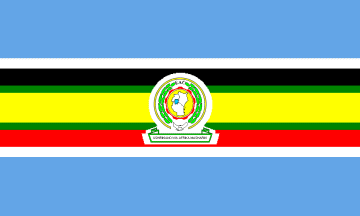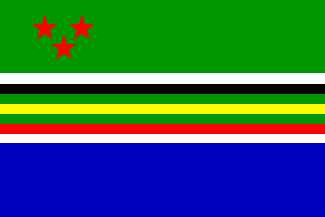See also:
- Kenya
- Tanzania
- Uganda
- British East Africa (pre-independence)
East African Commission
The East African Commission used a green over blue flag with several thin lines in between: white, black, green, yellow, green, red, white. That made the flag look like a green-white-blue tricolour with several thin stripes in the white. The ratios of the stripes would be approximately 7:1:1:1:1:1:1:1:7 green, white, black, green, yellow, green, red, white, blue. Three red five-pointed stars are in upper hoist corner, arranged one under two.Zeljko Heimer, 5 July 1996
The East African Commission collapsed in 1972.
Bruce Berry, 2 May 1997
A New East African Association (1997)
Making A Mess Of The East African FlagBased on stories in The East African, June 16-22, 1997 by Charles Onyango-Obbo
The new East African flag was seen for the first time on the 9 June celebrations in Uganda. Ugandan president Museveni called it "a sign that we are working together for closer East African Cooperation." The flag is described as typical of most African flags, overdone, with much detail, and in the middle is a little map of Uganda, Kenya, Tanzania, surrounded by several items.
The flag was the result of a competition, and the product is a mishmash of the three flags of Uganda, Tanzania and Kenya and the little map, on a blue background.
Submitted by Mark Sensen, May 1999, precised by Rob Raeside, 30 May 1999.
 by Pascal Gross, 16 January 2001
by Pascal Gross, 16 January 2001
Bruce Berry, 2 May 1997
The flag comprises 9 horizontal stripes of unequal width. The first and last are the thickest and are in blue. A thinner white stripe separates the blue from a black stripe and red stripe at the top and bottom of the flag. These stripes in turn are separated by a thin green stripe from the middle, thicker, yellow stripe. The colour order of the stripes is therefore: blue, white, black, green, yellow, green, red, white and blue.
In the centre of the flag in the middle of the yellow stripe (extending across the green and into the black and red

